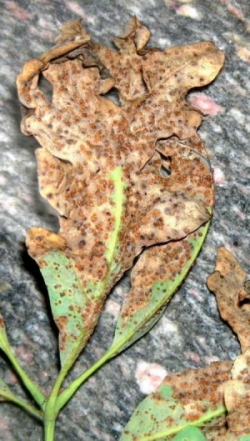April - June, 2010
FOREST HEALTH ALERT
White Oaks Turning Brown in Late Spring
White Oaks Turning Brown in Late Spring
Problem: Leaves on entire crowns of white oak trees turn brown in late Spring. In some cases, whole hillsides appear brown. Individual leaves turn brown starting at the margins, and sometimes curl up and turn black.
Tree Species: White oak (Quercus alba) primarily, and some other white oak group species.
Description: Leaves may be damaged by multiple causes, but the main cause in May 2010 appears to be high populations of a jumping oak gall wasp (Neuroterus sp.) These very tiny, stingless wasps cause pinhead-size galls (abnormal plant growths) to form on the undersides of leaves. Each round, button-like gall contains one wasp larva. Most galls drop from leaves in early summer. Brown pockmarks remain where galls had been attached. Brown, scorch-like areas appear on leaves where many galls are present. In more severe cases, leaves turn black, curl up and drop early from trees.
 |
| White oak leaves damaged by jumping oak galls (photo: S. Madison) |
Fallen galls are sometimes observed to "jump" due to vigorous movements of larvae within, much like moth larvae of "Mexican jumping beans." This behavior allows galls to fall deeper into grass and leaf litter where they are sheltered throughout the coming winter. Long periods of snow cover may provide further insulation from severe cold during winter. That snow cover, plus consistent cold temperatures (no winter warm-ups followed by severe freezes), may allow higher survival of overwintering gall wasps and help explain outbreaks like that of 2010.
These wasps have one generation per year. Damage to trees occurs only in the spring, although the effects will be visible throughout the summer. Outbreaks typically last for one or two years and then fade away as natural controls reduce gall wasp numbers again.
In years with cool wet springs, fungal diseases can be abundant on trees, and may also cause leaf browning. Anthracnose is common on white oak foliage in those conditions and has been observed on white oak leaf samples in 2010. However, it appears to be secondary to jumping oak galls for causing damage. Botryosphaeria twig canker causes leaves on infected small branches to wilt and turn brown, which results in "flagging" in the canopy during the summer. Typically, twig bark shrivels and turns brown where the canker occurs, near the junction with healthy tissue.
Recommendations: Galls and fungi that affect oak leaves rarely have a significant impact on tree health. Nearly all trees will recover, even if all leaves are brown. Controls are not warranted. By the time the damage is observed, any opportunity to treat has already passed for that year, and populations are likely to decline naturally. However, severe leaf damage stresses trees, particularly if most leaves on a tree are killed which results in a second flush of leaves emerging in summer. The best tactic is using good tree care practices that reduce stress (mulching, watering during drought, avoiding wounds due to lawnmowers and trimmers). Raking and removing or burning fallen leaves may help to reduce overwintering fungi or gall insects.
Further Information on the Web
http://ppdl.org/dd/id/jumping_oak_leaf_gall-oak.html
http://www.ipm.iastate.edu/ipm/hortnews/2006/5-24/oakantrhacnose.html
http://pubs.ext.vt.edu/450/450-726/450-726.html
Source: Forest Health Program, Missouri Department of Conservation - May 28, 2010